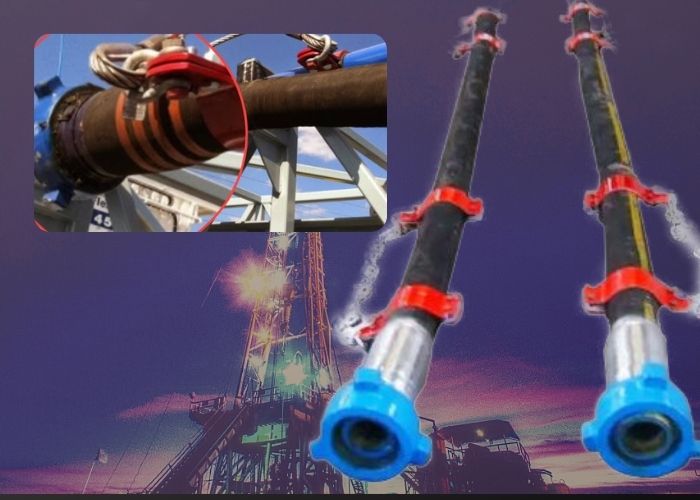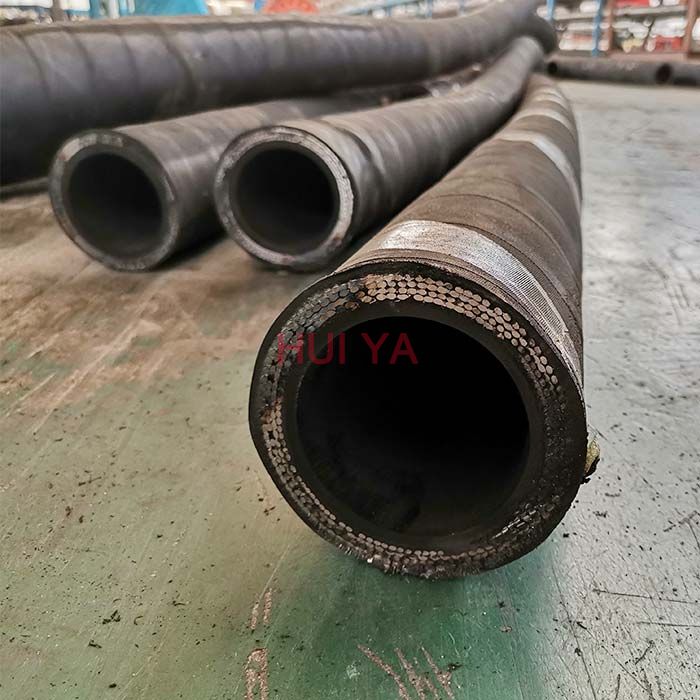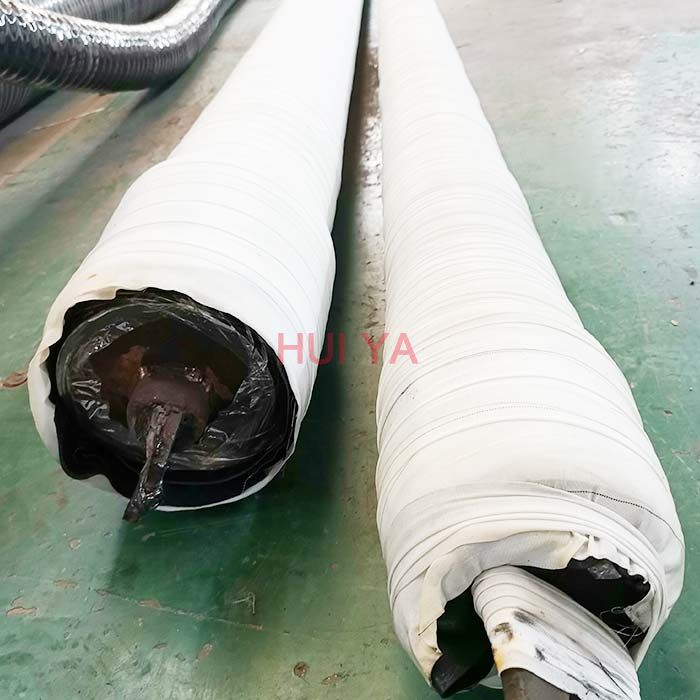kelly hose drilling definition brands

Flexible drilling rubber hoses play an important role in petroleum extraction. They should suffer high operating pressure, extreme operating temperature, abrasion and other inferior elements. Our special compounded synthetic rubber has been proven an effective and economical way to reject these problems. All our oilfield drill hoses are manufactured as API 7K or other related specifications.
Steel cable reinforcement loads most working pressure up to 15,000psi. The wires are usually zinc-plating or copper platting to improve steel wire resistant against rust and corrosion. Due to the thick reinforcement, the hoses should be handled or stored in correct way to avoid kicking or crushing. They will substantially decrease their rated operating pressure.
Rotary hose, Kelly hose, cement hose, mud hose, jumper hose and vibrator hose and choke & kill hoses are the most popular oilfield rubber hoses. They convey high-pressure drilling fluid from one place to another. Many end fittings are provided to satisfy different applications. Most end fittings are made according to API standards. Special order is also available.

A large-diameter (3- to 5-in inside diameter), high-pressure flexible line used to connect the standpipe to the swivel. This flexible piping arrangement permits the kelly (and, in turn, the drillstring and bit) to be raised or lowered while drilling fluid is pumped through the drillstring. The simultaneous lowering of the drillstring while pumping fluid is critical to the drilling operation.

A rotary/pumper hose is used in oil well drilling. It acts as the crucial instrument in the connection being made between the standpipe and the swivel.
A rotary hose is also used as a means of permitting the kelly to be either raised or lowered through the drilling process while also allowing the drill bit to be raised with the drillstring. For this reason, it is also often referred to as a “kelly hose.”
Rotary hoses also function during the process that allows the drilling fluid to be pumped through the hose when the bit and drillstring are raised and lowered.
This process is imperative in the completion of the drilling process. The drillstring portion of the drilling line and the connection to the rotary hose is thus crucial.
A large-diameter (3- to 5-in inside diameter), high-pressure flexible line used to connect the standpipe to the swivel. This flexible piping arrangement permits the kelly (and, in turn, the drillstring and bit) to be raised or lowered while drilling fluid is pumped through the drillstring. The simultaneous lowering of the drillstring while pumping fluid is critical to the drilling operation.
Made of heavy rubber and steel cables the hose is basicly flexible piping that allows the Kelly and the bit and drill string to be raised and lowered while the drilling fluid is pumped through drill string.
lowering the drill string and pumping drilling mud is very important to the drilling process and when these hoses go down or fail in service a entire rig can shut down.
Made of heavy rubber and steel cables the hose is basicly flexible piping that allows the Kelly and the bit and drill string to be raised and lowered while the drilling fluid is pumped through drill string.
Rotary Drilling/Pumper hose is mainly used for conveying water-based or oil-based mud and other fluids in the working temperature of -30 °C to +82 °C.
The reinforcement is made from 2-8 layers of high tensile and high strength spiraled steel wire, making the hose have solid structure and resistant to high pressure.
The cover is made from high quality synthetic rubber, mainly chloroprene rubber, making the hose resistant to abrasion, corrosion, cut, weather, ozone, aging and sunlight.
A Kelly hose (also known as a mud hose or rotary hose) is a flexible, steel reinforced, high pressure hose that connects the standpipe to the kelly (or more specifically to the goose-neck on the swivel above the kelly) and allows free vertical movement of the kelly while facilitating the flow of drilling fluid through the system and down the drill string.
Flexible drilling rubber hoses play an important role in petroleum extraction. They should suffer high operating pressure, extreme operating temperature, abrasion and other inferior elements. Our special compounded synthetic rubber has been proven an effective and economical way to reject these problems. All our oilfield drill hoses are manufactured as API 7K or other related specifications.
Steel cable reinforcement loads most working pressure up to 15,000psi. The wires are usually zinc-plating or copper platting to improve steel wire resistant against rust and corrosion. Due to the thick reinforcement, the hoses should be handled or stored in correct way to avoid kicking or crushing. They will substantially decrease their rated operating pressure.
We are global leader in the design, manufacture and supply of high pressure hoses.As drilling operation methods evolve, become deeper, with increasing pressure and higher temperatures,
We have over 50 years of experience in metallic reinforced bonded elastomer hoses and has been the first company to obtain certification for all three governing industry standards: API 7K, 16C and 17K standard.
We have since built up a broad portfolio for a variety of drilling applications, such as flexible choke & kill Lines, rotary & vibrator hoses, managed pressure drilling hoses to meet the needs of both onshore & offshore drillers and distributors.
Our key offering includes rotary drilling / vibrator hose grade D and E, choke and kill, cement and sour hoses. The supports the pumping of mud at very high pressure during drilling and exploration campaigns.
Protects the polymer lining from mechanical damage, prevents blistering in case of high pressure gas service and decompression with vacuum service, supports the wall of the flexible hose.
The lining material is selected to withstand chemical and heat effects of drilling mud, well effluents, cement slurry, hydraulic fluid or whatever substance is conveyed through the hose.
High-pressure mud hose also called rotary hose, vibrator hose or jumper hose, is used to convey drilling fluid from mud pump to the mud standpipe manifold on the drill floor.

A rotary hose is also used as a means of permitting the kelly to be either raised or lowered through the drilling process while also allowing the drill bit to be raised with the drillstring. For this reason, it is also often referred to as a “kelly hose.”
Rotary hoses also function during the process that allows the drilling fluid to be pumped through the hose when the bit and drillstring are raised and lowered. This process is imperative in the completion of the drilling process.
These rotary vibrator hoses are made up of the Gates range of Black Gold hoses that meet the severe demands of today’s drilling methods including directional drilling, pressure pulses and elevated temperatures.

If Wiktionary has a definition already, change this tag to {{TWCleanup2}} or else consider a soft redirect to Wiktionary by replacing the text on this page with {{Wi}}.
If Wiktionary does not have the definition yet, consider moving the whole article to Wiktionary by replacing this tag with the template {{Copy to Wiktionary}}.

13 Causes Of Hose Failure 1) Mis-application -Perhaps the greatest cause of failure is using a hose, fitting, or clamp in an application that it is not designed for.
2) Kinking at or near the fittings -Once the barb of the fitting cuts into the tube of the hose, the product being conveyed can escape into the reinforcement and eventually lead to bubbling or blistering of the cover within several feet of the end.
3) Temperature Exposure- As temperature increases pressure ratings decrease. Excessive hot or cold temperatures will lead to discoloration, cracking, or hardness - as well the build up of static electricity if hose wire has not been ground properly.
5) External damage to hose carcass -Kinks, crushed sections, and cover damage which exposes reinforcement will eventually break down the reinforcement and lead to a hose failure.
6) Exceeding the minimum bend radius -Kinking, crushing, or forcing a hose to bend beyond its minimum bend radius (measured from the inside edge of the hose, not the centerline). This is commonly seen on high pressure hoses or vacuum hoses.
7) Defective hose or improperly installed or selected clamp -Failure from a defective hose will typically occur in the first few hours of service, such as pin holes, blow-outs, or tube and cover separation. Improperly installed or selected clamps can result in the coupling ejecting from the end of the hose. Always confirm the manufacturer recommendations based on STAMPED information.
8) Tube or cover not compatible with fluids or environment -Usually results in discoloration, swelling, sponginess, or the breakdown of the hose carcass. For material handling hoses, always rotate to ensure even wear of the hose tube.
9) Old age -Hose is not ‘pipe’, it is a flexible component that will degrade over time. Shelf or service life will range from 1 to 20+ years, depending on its composition, application, and environment. Older hoses become discoloured, stiff, or burst at low pressures.
10) Incorrect hose length -Too short of a length does not allow the hose to expand/contract due to changes in pressure or temperature and causes excessive stress on the fittings or hose reinforcement.
11) Twisting hose during installation or service -Twisting a hose rather than naturally bending the hose will reduce life. It is estimated a 7% twist when installing a hose in a permanent application can reduce hose life by 90%.
12) Poor workmanship -Hose and fittings are made of a unique blend of different materials with complex manufacturing methods - human error, inconsistent machinery, or poor product quality or raw materials can result in defects or variances greater than allowable tolerances. As for failure at the end fitting, ends blowing off assemblies can be a result of sub-standard coupling procedures or due to the “mixing-and-matching” of incompatible hose, couplings, or clamps.
13) Contaminated media being transferred -Foreign particles or residue in the fluid or air can flow through the tube and break it down or wear it out prematurely. Always clean hoses prior to installing in field to ensure there is no cross-contamination.

Hengyu Group Hydraulic Fluid Technology Hebei Co., Ltd.is the first-class manufacturer specialized in designing and manufacture different kinds of hydraulic & industrial hose in China with the experience of 30 years, Our hoses are produced according to the ISO9001: 2008, API 7K, ISO/TS 29001 .
We manufacturer hydraulic hoses and connectors according to the ISO9001:2008, ISO/TS 29001 and API Q1. We help our customer develop special and quality goods for their needs.

suitable for rotary hose for flexible connection between the top of the drilling riser and the vertically movable water faucet in the oil drilling and mud delivery systems,and for the adjustment of installing error between the drilling pump line and the riser for the connection and vibration isolation.
It is also suitable for delivering in large quantity at high pressure the water-based or oil-based mud with the min. aniline point at 66℃ pumped out of rotary drilling equipment.Moreover, it resists to corrosion from hydrogen sulfide and delivers water, oil,mud and other high-pressure media in borehole operation in oil field.
Application:Used as Flexible connection between standpipe and swivel (Rotary Drilling) or between pump and standpipe (Rotary Vibrator) for pumping mud at extra high pressures in oil drilling and natural gas exploration work (including 50D, 70D).
Hose Reinforcement:2~ 6 layers spiraled by single high-strength steel wire, and rubber as a binder to make the layers into one complete and sound construction

Kelly bars are key components in the execution of boreholes by hydraulic rotary drilling rigs. Teleskopic Kelly bars transfer torque and crowd force from the rotary drive to the drilling tool. Hunan HM Machinery Co is a highly specialized manufacturer of telescopic kelly bars to be applied to any type of piling rig available in the market such as Bauer, Sany, Xcmg, Zoomlion, Sunward, Soilmec, IMT, Mait.... Kelly bars are featuring specific construction details:
HM Machinery Co kelly bars are designed by technicians and engineers with over 10 years experience. Construction and welding manufacturing process of kelly bars is by means of high quality materials and high mechanical features steel, provided with origin and quality certificates to guarantee long-life and reliability of the product after accurate engineering process.

A kelly hose is a piece of mining equipment. Specifically, it refers to a piece of equipment used in the mining of fluid or semi-fluid resources, such as oil and natural gas. The main purpose of a kelly hose is to allow the drill string to be raised and lowered at the same time that drill fluid is being pumped through it. This is important, as drill fluid is critical to the mining process.
In most cases, a kelly hose is classified as a large-diameter hose. This means that the inside diameter is usually between 3 and 5 inches (about 7.6 cm and 12.7 cm). This wide diameter allows for a significant rate of flow and reduces the likelihood of a blockage occurring in the hose.
The kelly hose must also be able to withstand large amounts of pressure. This applies primarily to the pressure of the fluid flowing through the hose. For this reason, it is often made of highly durable material and is generally reinforced with steel.
In a derrick or drilling rig, the kelly hose connects the standpipe, which is the rigid metal shaft that delivers the mining fluid, to the swivel, which is the piece that supports the weight of and controls the rotation of the drill string. Its purpose is to provide a flexible drilling fluid conduit, as a rigid conduit would be unable to move with the swivel and would therefore disallow movement of the drill string and, subsequently, the bit.
The drilling fluid, sometimes called drilling mud, carried by a kelly hose is critical to operations in several ways. It keeps the bit cool, which helps reduce friction and failure. It also cleans the bit and carries away drill cuttings so they cannot damage the drill assembly. Some varieties are used for additional purposes, such as preventing corrosion and providing hydrostatic pressure. Drilling fluid is not necessarily fluid, but may, in fact, be a solid, liquid, gas or other combined form.
The kelly hose is so named because of its connection with the kelly, the actual mechanical piece that ejects the drilling fluid over the drill string. It may alternatively be called a mud hose or a rotary hose. Failure can occur, despite the rugged construction of the hose. Such failure can lead to damage to the rig or a failure to operate. Failed kelly hoses must be repaired or replaced before mining operations can safely and effectively resume.

Of course, those do still exist. And they have their place too, in situations where you might need something that tough. We recommend one made from the traditional rubber, in fact, as well as the best in class for other situations.
Many people who have used a Flexilla garden hose swear it’s the greatest ever made. It also does well in expert testing, where it lives up to its kink-free claims.
The manufacturer says the material is lead-free and drinking water safe, although it’s not tested or certified by any of the agencies that verify those claims. They also say it can withstand temperatures from -40 to 150°F, and owners attest that it holds up well in hot temperatures.
Need a tough garden hose for washing your car, for powering a pressure washer, or that can live outside during the worst winters? Then the Craftsman Premium offering should be at the top of your list.
This is a popular pick for landscape professionals and those who need something that can stand up to light commercial applications, such as mixing cement.
This product is as durable as they come. We saw a number of comments from owners who ran theirs over with their car (accidentally, of course) and reported that the couplings didn’t crush, and the hose was oblivious.
If you’re looking for something that’s a little easier on the wallet, but still easy to wrangle in a small garden, we recommend the Gatorhyde Coiled Garden Hose.
This setup includes the reel, a 9/16-inch diameter, 82-foot hose with a seven function nozzle, and a 6.5-foot leader hose. Many owners like that 82-foot length, saying it’s a nice alternative to having to choose between that standard 50 or 100 feet.
The Hoselink is intended to be wall-mounted and, when mounted, the reel can swivel 180 degrees. You will need a drill for the installation, so keep that in mind.
Users say the reel is easy to install and use, and the hose retracts very easily with the automatic rewind. Many also note that they’ve had one for several years and it is holding up well. The whole setup weighs 30 pounds.
The hose and reel are made from PVC and polypropylene with brass couplers, and stainless steel and plastic fittings. It is not food grade, so it’s probably best to avoid filling the dog’s bowl with this one.
The hose in integral to the reel and cannot be replaced. One nice feature is that the reel keeps the hose protected even in extreme weather conditions.
It’s not as sturdy as a traditional model, and some users complain of leakage and deterioration. However, the latter issue seemed to be more of a problem when the hose was left out continually, rather than rolling it up and storing it after each use.
Ideal for watering delicate new grasses or long, narrow areas like the side of a house, the Gilmour Vinyl Sprinkler Hose is a very versatile choice that can also function as a soaker. Just position it with the white side up for sprinkling, and the white side down for soaking.
The fittings are nickel plated. It measures the standard 5/8 inch in diameter. It only comes in a 50-foot length, but you can attach up to three hoses. Gilmour offers a lifetime warranty.




 8613371530291
8613371530291